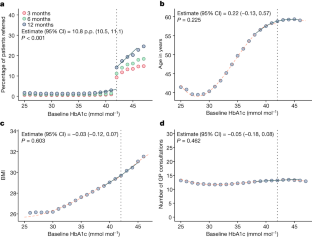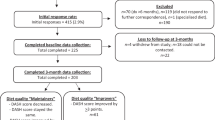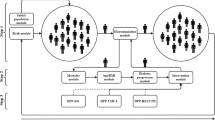Abstract
Diabetes is a leading cause of morbidity, mortality and cost of illness1,2. Health behaviours, particularly those related to nutrition and physical activity, play a key role in the development of type 2 diabetes mellitus3. Whereas behaviour change programmes (also known as lifestyle interventions or similar) have been found efficacious in controlled clinical trials4,5, there remains controversy about whether targeting health behaviours at the individual level is an effective preventive strategy for type 2 diabetes mellitus6 and doubt among clinicians that lifestyle advice and counselling provided in the routine health system can achieve improvements in health7,8,9. Here we show that being referred to the largest behaviour change programme for prediabetes globally (the English Diabetes Prevention Programme) is effective in improving key cardiovascular risk factors, including glycated haemoglobin (HbA1c), excess body weight and serum lipid levels. We do so by using a regression discontinuity design10, which uses the eligibility threshold in HbA1c for referral to the behaviour change programme, in electronic health data from about one-fifth of all primary care practices in England. We confirm our main finding, the improvement of HbA1c, using two other quasi-experimental approaches: difference-in-differences analysis exploiting the phased roll-out of the programme and instrumental variable estimation exploiting regional variation in programme coverage. This analysis provides causal, rather than associational, evidence that lifestyle advice and counselling implemented at scale in a national health system can achieve important health improvements.
This is a preview of subscription content, access via your institution
Access options
Access Nature and 54 other Nature Portfolio journals
Get Nature+, our best-value online-access subscription
$29.99 / 30 days
cancel any time
Subscribe to this journal
Receive 51 print issues and online access
$199.00 per year
only $3.90 per issue
Buy this article
- Purchase on Springer Link
- Instant access to full article PDF
Prices may be subject to local taxes which are calculated during checkout



Similar content being viewed by others
Data availability
This study used data from the CPRD Aurum and NHS England HES APC database. The data are available from CPRD (https://cprd.com) but restrictions apply to the availability of these data, which were used under license for the current study and so are not publicly available. Owing to CPRD license restrictions, we are unable to share data.
Code availability
All medical codes and algorithms to define variables and R analysis code are available in the Supplementary Information or at the OSF repository (https://osf.io/rqz6x/?view_only=abc4c7a3abcb457596cec9fe2664f542).
References
Lin, X. et al. Global, regional and national burden and trend of diabetes in 195 countries and territories: an analysis from 1990 to 2025. Sci. Rep. 10, 14790 (2020).
Bommer, C. et al. The global economic burden of diabetes in adults aged 20–79 years: a cost-of-illness study. Lancet Diabetes Endocrinol. 5, 423–430 (2017).
Asif, M. The prevention and control the type-2 diabetes by changing lifestyle and dietary pattern. J. Educ. Health Promot. 3, 1 (2014).
Taheri, S. et al. Effect of intensive lifestyle intervention on bodyweight and glycaemia in early type 2 diabetes (DIADEM-I): an open-label, parallel-group, randomised controlled trial. Lancet Diabetes Endocrinol. 8, 477–489 (2020).
Galaviz, K. I. et al. Interventions for reversing prediabetes: a systematic review and meta-analysis. Am. J. Prev. Med. https://doi.org/10.1016/j.amepre.2021.10.020 (2022).
Barry, E., Roberts, S., Finer, S., Vijayaraghavan, S. & Greenhalgh, T. Time to question the NHS diabetes prevention programme. Br. Med. J. https://doi.org/10.1136/bmj.h4717 (2015).
Rubio-Valera, M. et al. Barriers and facilitators for the implementation of primary prevention and health promotion activities in primary care: a synthesis through meta-ethnography. PLoS ONE 9, e89554 (2014).
Hébert, E. T., Caughy, M. O. & Shuval, K. Primary care providers’ perceptions of physical activity counselling in a clinical setting: a systematic review. Br. J. Sports Med. 46, 625–631 (2012).
Dewhurst, A., Peters, S., Devereux-Fitzgerald, A. & Hart, J. Physicians’ views and experiences of discussing weight management within routine clinical consultations: a thematic synthesis. Patient Educ. Couns. 100, 897–908 (2017).
Imbens, G. W. & Lemieux, T. Regression discontinuity designs: a guide to practice. J. Econom. 142, 615–635 (2008).
Saeedi, P. et al. Global and regional diabetes prevalence estimates for 2019 and projections for 2030 and 2045: results from the International Diabetes Federation Diabetes Atlas, 9th edition. Diabetes Res. Clin. Pract. 157, 107843 (2019).
Diabetes Prevention Program Research Group. Long-term effects of lifestyle intervention or metformin on diabetes development and microvascular complications over 15-year follow-up: the Diabetes Prevention Program Outcomes Study. Lancet Diabetes Endocrinol. 3, 866–875 (2015).
Brink, S. The Diabetes Prevention Program: how the participants did it. Health Aff. 28, 57–62 (2009).
Type 2 Diabetes: Prevention in People at High Risk (NICE, 2012); www.nice.org.uk/guidance/ph38.
Henry, J. A. et al. Lifestyle advice for hypertension or diabetes: trend analysis from 2002 to 2017 in England. Br. J. Gen. Pract. 72, e269–e275 (2022).
Kardakis, T., Jerdén, L., Nyström, M. E., Weinehall, L. & Johansson, H. Implementation of clinical practice guidelines on lifestyle interventions in Swedish primary healthcare—a two-year follow up. BMC Health Serv. Res. 18, 227 (2018).
Milder, I. E., Blokstra, A., de Groot, J., van Dulmen, S. & Bemelmans, W. J. Lifestyle counseling in hypertension-related visits—analysis of video-taped general practice visits. BMC Fam. Pract. 9, 58 (2008).
Sheppard, J. P. et al. Association of guideline and policy changes with incidence of lifestyle advice and treatment for uncomplicated mild hypertension in primary care: a longitudinal cohort study in the Clinical Practice Research Datalink. BMJ Open 8, e021827 (2018).
Lemp, J. M. et al. Use of lifestyle interventions in primary care for individuals with newly diagnosed hypertension, hyperlipidaemia or obesity: a retrospective cohort study. J. R. Soc. Med. 115, 289–299 (2022).
Booth, H. P., Prevost, A. T. & Gulliford, M. C. Access to weight reduction interventions for overweight and obese patients in UK primary care: population-based cohort study. BMJ Open 5, e006642 (2015).
Irving, G. et al. International variations in primary care physician consultation time: a systematic review of 67 countries. BMJ Open 7, e017902 (2017).
Keyworth, C., Epton, T., Goldthorpe, J., Calam, R. & Armitage, C. J. ‘It’s difficult, I think it’s complicated’: Health care professionals’ barriers and enablers to providing opportunistic behaviour change interventions during routine medical consultations. Br. J. Health Psychol. https://doi.org/10.1111/bjhp.12368 (2019).
Kennedy-Martin, T., Curtis, S., Faries, D., Robinson, S. & Johnston, J. A literature review on the representativeness of randomized controlled trial samples and implications for the external validity of trial results. Trials 16, 495 (2015).
Ford, J. G. et al. Barriers to recruiting underrepresented populations to cancer clinical trials: a systematic review. Cancer 112, 228–242 (2008).
Rogers, J. R., Liu, C., Hripcsak, G., Cheung, Y. K. & Weng, C. Comparison of clinical characteristics between clinical trial participants and nonparticipants using electronic health record data. JAMA Netw. Open 4, e214732 (2021).
Suvarna, V. Phase IV of drug development. Perspect. Clin. Res. 1, 57–60 (2010).
Hagger, M. S. & Weed, M. DEBATE: do interventions based on behavioral theory work in the real world? Int. J. Behav. Nutr. Phys. Act. 16, 36 (2019).
Marsden, A. M. et al. ‘Finishing the race’—a cohort study of weight and blood glucose change among the first 36,000 patients in a large-scale diabetes prevention programme. Int. J. Behav. Nutr. Phys. Act. 19, 7 (2022).
Cattaneo, M. D., Idrobo, N. & Titiunik, R. A Practical Introduction to Regression Discontinuity Designs (Cambridge Univ. Press, 2019).
Valabhji, J. et al. Early outcomes from the English National Health Service Diabetes Prevention Programme. Diabetes Care 43, 152–160 (2020).
Bärnighausen, T. et al. Quasi-experimental study designs series—paper 7: assessing the assumptions. J. Clin. Epidemiol. 89, 53–66 (2017).
Selvin, E. et al. Glycated hemoglobin, diabetes and cardiovascular risk in nondiabetic adults. N. Engl. J. Med. 362, 800–811 (2010).
Garg, N. et al. Hemoglobin A1c in nondiabetic patients: an independent predictor of coronary artery disease and its severity. Mayo Clin. Proc. 89, 908–916 (2014).
Lipsitch, M., Tchetgen Tchetgen, E. & Cohen, T. Negative controls: a tool for detecting confounding and bias in observational studies. Epidemiology 21, 383–388 (2010).
Persson, R. et al. CPRD Aurum database: assessment of data quality and completeness of three important comorbidities. Pharmacoepidemiol. Drug Saf. 29, 1456–1464 (2020).
Jonas, D. E. et al. Screening for prediabetes and type 2 diabetes: updated evidence report and systematic review for the US preventive services task force. JAMA 326, 744 (2021).
Pronk, N. P. Structured diet and physical activity programmes provide strong evidence of effectiveness for type 2 diabetes prevention and improvement of cardiometabolic health. Evid. Based Med. 21, 18 (2016).
Galaviz, K. I. et al. Global diabetes prevention interventions: a systematic review and network meta-analysis of the real-world impact on incidence, weight and glucose. Diabetes Care 41, 1526–1534 (2018).
Mudaliar, U. et al. Cardiometabolic risk factor changes observed in diabetes prevention programs in US settings: a systematic review and meta-analysis. PLoS Med. 13, e1002095 (2016).
Cardona-Morrell, M., Rychetnik, L., Morrell, S. L., Espinel, P. T. & Bauman, A. Reduction of diabetes risk in routine clinical practice: are physical activity and nutrition interventions feasible and are the outcomes from reference trials replicable? A systematic review and meta-analysis. BMC Public Health 10, 653 (2010).
Diabetes Prevention Programme: Non-Diabetic Hyperglycaemia, January to December 2021. National Diabetes Audit (NHS Digital, 2022); https://digital.nhs.uk/data-and-information/publications/statistical/national-diabetes-audit/dpp-q3-21-22-data.
Whelan, M. & Bell, L. The English National Health Service Diabetes Prevention Programme (NHS DPP): a scoping review of existing evidence. Diabet. Med. 39, e14855 (2022).
Calderón-Larrañaga, S. et al. Unravelling the potential of social prescribing in individual-level type 2 diabetes prevention: a mixed-methods realist evaluation. BMC Med. 21, 91 (2023).
Poupakis, S., Kolotourou, M., MacMillan, H. J. & Chadwick, P. M. Attendance, weight loss and participation in a behavioural diabetes prevention programme. Int. J. Behav. Med. https://doi.org/10.1007/s12529-022-10146-x (2023).
Katzke, V. A., Kaaks, R. & Kühn, T. Lifestyle and cancer risk. Cancer J. 21, 104–110 (2015).
Silverio, A. et al. Cardiovascular risk factors and mortality in hospitalized patients with COVID-19: systematic review and meta-analysis of 45 studies and 18,300 patients. BMC Cardiovasc. Disord. 21, 23 (2021).
Hawkes, R. E., Cameron, E., Cotterill, S., Bower, P. & French, D. P. The NHS Diabetes Prevention Programme: an observational study of service delivery and patient experience. BMC Health Serv. Res. 20, 1098 (2020).
Penn, L. et al. NHS Diabetes Prevention Programme in England: formative evaluation of the programme in early phase implementation. BMJ Open 8, e019467 (2018).
Diabetes Prevention Programme. NHS https://gps.northcentrallondon.icb.nhs.uk/service/diabetes-prevention-programme-dpp (2023).
McManus, E., Meacock, R., Parkinson, B. & Sutton, M. Population level impact of the NHS Diabetes Prevention Programme on incidence of type 2 diabetes in England: an observational study. Lancet Reg. Health Eur. 19, 100420 (2022).
National Diabetes Audit. Audit, survey, other reports and statistics. NHS Digital https://digital.nhs.uk/data-and-information/publications/statistical/national-diabetes-audit (2018).
Wolf, A. et al. Data resource profile: Clinical Practice Research Datalink (CPRD) Aurum. Int. J. Epidemiol. 48, 1740–1740g (2019).
Herbert, A., Wijlaars, L., Zylbersztejn, A., Cromwell, D. & Hardelid, P. Data resource profile: Hospital Episode Statistics Admitted Patient Care (HES APC). Int. J. Epidemiol. 46, 1093–1093i (2017).
Sammon, C. J., Leahy, T. P. & Ramagopalan, S. Nonindependence of patient data in the clinical practice research datalink: a case study in atrial fibrillation patients. J. Comp. Eff. Res. 9, 395–403 (2020).
Hernán, M. A. Methods of public health research—strengthening causal inference from observational data. N. Engl. J. Med. 385, 1345–1348 (2021).
Hernán, M. A. & Robins, J. M. Using big data to emulate a target trial when a randomized trial is not available. Am. J. Epidemiol. 183, 758–764 (2016).
Non-Diabetic Hyperglycaemia, 2019-20 (NHS Digital, 2021); https://files.digital.nhs.uk/31/C59C4B/NDA_NDH_MainReport_2019-20_V1.pdf.
Davidson, J. Clinical codelist—HES—Major Adverse Cardiovascular Event. London School of Hygiene & Tropical Medicine https://doi.org/10.17037/DATA.00002198 (2021).
Imbens, G. & Kalyanaraman, K. Optimal bandwidth choice for the regression discontinuity estimator. Rev. Econ. Stud. 79, 933–959 (2012).
Calonico, S., Cattaneo, M. D. & Titiunik, R. Robust nonparametric vonfidence intervals for regression-discontinuity designs: robust nonparametric confidence intervals. Econometrica 82, 2295–2326 (2014).
Calonico, S., Cattaneo, M. D., Farrell, M. H. & Titiunik, R. Regression discontinuity designs using covariates. Rev. Econ. Stat. 101, 442–451 (2019).
R Core Team. R: A Language and Environment for Statistical Computing (R Foundation for Statistical Computing, 2022).
Calonico, S., Cattaneo, M. D., Farrell, M. H. & Titiunik, R. rdrobust: robust data-driven statistical inference in regression-discontinuity designs. R package v.2.1.0 (2022).
Callaway, B. & Sant’Anna, P. H. C. Difference-in-differences with multiple time periods. J. Econ. 225, 200–230 (2021).
Callaway, B. & Sant’Anna, P. did: Difference in Differences. R package v.2.1.2 (2022).
Proposed CCG Configuration and Member Practices Published. NHS England www.england.nhs.uk/2012/05/ccg-configuration/ (2012).
Output Area to Primary Care Organisation to Strategic Health Authority (December 2011) Lookup in England and Wales. ONS Geography Office of National Statistics https://geoportal.statistics.gov.uk/datasets/ons::output-area-to-primary-care-organisation-to-strategic-health-authority-december-2011-lookup-in-england-and-wales-1/about (2018).
Lower Layer Super Output Area (2011) to Clinical Commissioning Group to Local Authority District (April 2021) Lookup in England. ONS Geography Office of National Statistics https://geoportal.statistics.gov.uk/datasets/ons::lower-layer-super-output-area-2011-to-clinical-commissioning-group-to-local-authority-district-april-2021-lookup-in-england-1/about (2021).
Gaure, S. lfe: linear group fixed effects. R package v.2.8-8 (2022).
Ho, D. E., Imai, K., King, G. & Stuart, E. A. MatchIt: nonparametric preprocessing for parametric causal inference. J. Stat. Softw. 42, 1–28 (2011).
Snowden, J. M., Rose, S. & Mortimer, K. M. Implementation of G-computation on a simulated data set: demonstration of a causal inference technique. Am. J. Epidemiol. 173, 731–738 (2011).
Greifer, N. & Stuart, E. A. Choosing the causal estimand for propensity score analysis of observational studies. Preprint at https://doi.org/10.48550/ARXIV.2106.10577 (2021).
Chatton, A. et al. G-computation, propensity score-based methods and targeted maximum likelihood estimator for causal inference with different covariates sets: a comparative simulation study. Sci. Rep. 10, 9219 (2020).
Arel-Bundock, V. marginaleffects: marginal effects, marginal means, predictions and contrasts. R package v.0.7.1 (2022).
Acknowledgements
This study is based on data from the Clinical Practice Research Datalink obtained under license from the UK Medicines and Healthcare products Regulatory Agency. The data are provided by patients and collected by the NHS as part of their care and support. The interpretation and conclusions contained in this study are those of the authors alone. This work was supported by the Alexander von Humboldt Foundation through the Alexander von Humboldt Professorship awarded to T.B. Data storage and computing resources used in this work were supported by the Ministry of Science, Research and the Arts Baden-Wuerttemberg, Germany, German Research Foundation, the state of Baden-Wuerttemberg, Germany and the German Research Foundation grant no. INST 35/1314-1 FUGG. P.G. was supported by the National Institute of Allergy and Infectious Diseases (1DP2AI171011) and the Chan Zuckerberg Biohub investigator award. J.M.L. acknowledges support from the German Academic Scholarship Foundation.
Author information
Authors and Affiliations
Contributions
J.M.L., C.B., A.J., J.I.D., S.V. and P.G. conceived of the research. T.B., S.V. and P.G. acquired funding for the research project. J.M.L., M.X. and F.M. curated the data. J.M.L., M.X., C.B. and P.G. designed the statistical analyses with consults from F.M., T.B. and S.V. J.M.L. and M.X. analysed the data. C.B. and P.G. supervised the analysis. J.M.L. and P.G. wrote the paper with edits from C.B., M.X., F.M., A.J., J.I.D., T.B. and S.V. All authors approved the final manuscript.
Corresponding author
Ethics declarations
Competing interests
The authors declare no competing interests.
Peer review
Peer review information
Nature thanks Ziyad Al-Aly, Theis Lange and the other, anonymous, reviewer(s) for their contribution to the peer review of this work. Peer reviewer reports are available.
Additional information
Publisher’s note Springer Nature remains neutral with regard to jurisdictional claims in published maps and institutional affiliations.
Extended data figures and tables
Extended Data Fig. 1 Trends in glycated haemoglobin (HbA1c) before, during and after programme roll-out.
Weighted average HbA1c in one-year intervals from April 2015 to March 2020, for (a) wave 1 and (b) wave 2 practices (intervention) compared to wave 3 practices (control). The y-axis does not start from 0, weighting by number of individuals for each practice, by year. The roll-out of the NHS DPP started in June 2016 for wave 1, in April 2017 for wave 2 and in April 2018 for wave 3.
Extended Data Fig. 2 Regional and temporal variation in NHS DPP programme implementation.
(a) Share of patients eligible for NHS DPP derived via official practice eligibility by roll-out wave and (b) share of patients referred to NHS DPP in each of the nine Strategic Health Authorities.
Rights and permissions
Springer Nature or its licensor (e.g. a society or other partner) holds exclusive rights to this article under a publishing agreement with the author(s) or other rightsholder(s); author self-archiving of the accepted manuscript version of this article is solely governed by the terms of such publishing agreement and applicable law.
About this article
Cite this article
Lemp, J.M., Bommer, C., Xie, M. et al. Quasi-experimental evaluation of a nationwide diabetes prevention programme. Nature 624, 138–144 (2023). https://doi.org/10.1038/s41586-023-06756-4
Received:
Accepted:
Published:
Issue Date:
DOI: https://doi.org/10.1038/s41586-023-06756-4
This article is cited by
Comments
By submitting a comment you agree to abide by our Terms and Community Guidelines. If you find something abusive or that does not comply with our terms or guidelines please flag it as inappropriate.



